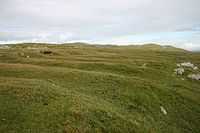Lazy bed


Lazy bed is a method of arable cultivation. Rather like cord rig cultivation, parallel banks of ridge and furrow are dug by spade although lazy beds have banks that are bigger, up to 2.5m in width, with narrow drainage channels between them.
Although it is largely extinct, it is still to be found in parts of the Hebrides where lazybeds are known as feannagan (Scottish Gaelic pronunciation: [fjan̪ˠakən]) in Scottish Gaelic, and the west of Ireland. In these places, the method used is normally to lift up sods of peat and apply desalinated seaweed fertiliser to improve the ground. Potatoes were often grown in this way in these regions, until the potato blight Phytophthora infestans caused the potato famine in the Highlands and Ireland.
It was used in southern parts of Britain from the post-Roman period until the post-medieval period, and across much of Ireland and Scotland until the 19th century.
See also
External links
| Wikimedia Commons has media related to lazy beds. |